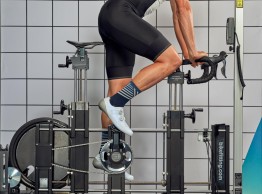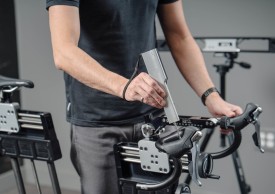Mistakes you make when adjusting your bike
Achieving the ideal position on the bike is not an easy task even though it is something that has been simplified with all the evolution that the field of biomechanics has undergone. Often small errors in adjustment or in our equipment can be the origin of discomfort that does not make us enjoy the bicycle. These are the most common.

Discover what are the common mistakes that are usually made when we look for the ideal position on the bike
Although science has fully entered the adjustment of the cyclist's position on the bike, standardizing the process of biomechanical analysis to the extreme where there are even mobile applications capable of determining our ranges of movement and angles on the bike with just a small video of us pedaling on the roller, there is still a small number of cases in which achieving the ideal adjustment is not trivial or falls into errors that trigger that we are not able to go comfortable on the bike.
The biomechanical analysis system is just a tool
Although biomechanical study systems are increasingly accurate and the methodology is increasingly standardized, there are many who, after going through one of these studies, do not manage to go well on the bicycle. It is often forgotten that this is just an analysis tool that provides data on the angles at which the different body segments are positioned and their ranges of movement during pedaling.
RECOMENDADO

Complete list of the highest paid cyclists of 2025

How many calories are burned when cycling

What is heart rate variability and how does it affect the cyclist?

Change wheels if you want to transform your bike's behavior

What bike size do you need? Here's how to find out

How does age affect performance and recovery?
However, an experienced person is needed to interpret these numbers, especially when the cyclist is out of the standard. The biomechanic must have the necessary knowledge in the first place to assess the cyclist's circumstances, it is not the same a weekend cyclist than a competitor and propose reasonable solutions to the cyclist. Sometimes, no matter how determined the cyclist is that his next bike is a competition model like those used in the World Tour, the biomechanic, often the manager of the store that is going to sell him the bike, should be able to tell him that that bike is not suitable for him.

Therefore, the first step to not make a mistake is to trust reputable experienced biomechanics and guarantee us a correct follow-up after the adjustment and the necessary tweaks during the adaptation period to ensure that our position on the bike is perfect. Avoid biomechanics that continue to use traditional formulas to make their adjustments or base it on angle measurement in static positions. Anything other than a dynamic analysis should be discarded today when making the adjustment on the bike.
Overlook the adaptation period
After a biomechanical study, especially if the changes have been broad, it is necessary for the body to assume the new placement on the bike. We have to ride the bike and note our perceptions to convey them to the biomechanic and, if necessary, make tweaks in the placement.
However, many cyclists are not patient enough and, after several days where they find themselves strange on the bike and do not finish assimilating the position, instead of indicating it to the biomechanic, they end up returning to their lifelong position.
Buy the bike before going through the biomechanic
Modern biomechanical studies, with robotic colt systems, allow us to simulate the position on any bicycle on the market and test how we would go with different adjustments. It is highly recommended, if we are going to change bikes, to do the study before to choose, not only the correct frame size but also a stem length, a handlebar with a reach, drop and suitable width or the saddle that best suits our ischial width and hip flexion capacity.

Then, once the bike is purchased following these indications, we should return to the biomechanic so that he is the one who makes the precise adjustment of the bike ensuring that the measures to which it adjusts coincide exactly with those obtained in the study.
Not taking into account the modification of components and accessories
A change of handlebar, pedals, shoes or saddle, even worn cleats, can completely disrupt our placement on the bike. Therefore, every time one of the elements that affect the contact points between the cyclist and the bike is modified, it is necessary to retouch the position so that it returns to the one obtained in the biomechanical study.

Measuring the bike and its adjustment is not a trivial task to do at home and less if we are looking for the highest precision. In fact, systems like Retül use the same camera that is used in the study to, through a specially designed sensor, measure the bike's adjustment with total precision. For its part, other adjustment systems like Bikefitting have a colt that allows you to adjust the different parts of the bike to the millimeter.
Pedaling at a leisurely pace during the biomechanical study
A mistake that many biomechanics make is not asking those who go through the study to make a minimum of effort. You will all agree that, except when the bike is very poorly adjusted, which is not usually the case, discomfort appears when we have been pedaling for several hours or when we make an effort.
That is why a competent biomechanic should place a certain resistance on the roller on which he mounts our bike or on the colt he uses so that we make a certain pedaling effort during it that allows the possible problems that exist in the sports gesture to be shown. In any case, it is not always achieved or, in some cases, the pedaling in the study varies from that of the real world. The reason is because the colt or the roller do not have the ability to tilt or move sideways which are gestures that many make on the road imperceptibly.
Again, there is the importance of follow-up by the biomechanic after the study is carried out so that the necessary tweaks in the position can be carried out.
Assume the adjustment as something definitive
The position on the bike is not something written in stone. Different circumstances can make this vary significantly and it is necessary to readjust the bike. The clearest example is the cyclist who is forced to stop for months and gains quite a bit of weight. When he returns to the bike, out of shape, with a certain belly, he finds it impossible to tolerate the placement of his super sporty bike.

An injury can also mean that our position changes, for example, because we have some limitation of movement in some joint or our flexion capacity is limited. Needless to say, the better our shape and the more worked we have the flexibility and strength of the stabilizing muscles, the more versatility we will have when looking for more sporty positions.